Two railways rule the country. Is it time for more competition?
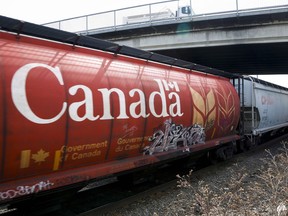
Article content
A wooden bridge burned down one morning this month on a rail line in northwestern Alberta, near an S-shaped bend in the Smoky River about 100 kilometres south of Grande Prairie. An old resource road was a few kilometres away. From there, first responders had to use all-terrain vehicles to get to the site. They found water close by and extinguished the fire. But the bridge was “totally destroyed,” according to RCMP Cpl. Deanna Fontaine.
Advertisement 2
Article content
Neither RCMP nor Canadian National Railway Co., which has its own police force investigating the incident, will say who or what they believe caused the fire on Oct. 5. Whatever happened, it quickly became clear how much had been depending on that old bridge across a valley in the middle of nowhere.
Article content
Without it, a 375-kilometre branch line, which juts out from CN’s main east-west corridor around Jasper National Park and runs north to Grande Prairie, was snapped into two useless pieces. Train traffic stopped in both directions for about a week. So the five major grain elevators on that line struggled to get their wheat, oats, barley and oilseeds to ships waiting at ports in Thunder Bay, along the St. Lawrence River and on the West Coast.
Advertisement 3
Article content
It was the worst time of year for that to be happening. A bumper grain harvest was just coming off the Prairies, global demand for grain was surging, and farmers were lining up to sell their new crop and generate some cash after some very lean months following last year’s drought.
On the morning after the fire, a grain elevator in Grande Prairie called Greg Sears, a farmer in nearby Sexsmith, Alta., and told him to hold off delivering 90 tonnes of canola for at least a few weeks on account of the rail shutdown.
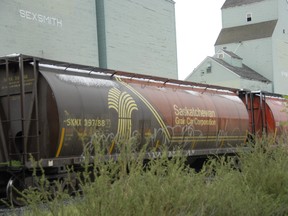
“That’s $75,000 to $100,000 of product that I’m not going to get a cheque for any time soon,” he said.
For some in the industry, the bridge was proof of how easily things can fall apart in the Canadian supply chain.
“The incident highlights the sector’s vulnerability to rail disruptions,” the credit rating agency DBRS Morningstar said in an Oct. 19 note about the fire. “What started out as a seemingly small disruption has the potential to snowball.”
Advertisement 4
Article content
Before the bridge, there was a washout in southern British Columbia that severed the main route into the Port of Vancouver for a week. Before that, it was the 2021 atmospheric rivers that choked off access to and from the British Columbia coast. And climate change likely will make it all worse — so much so that it probably won’t make sense to cram the Prairies’ entire bounty through a few “umbilical” rail lines in the Rockies, as one scholar put it in testimony at the House agriculture committee last month.
“All of the food production in this enormous area the size of Europe is going through essentially a small number of rail lines and through a couple of passes,” said Evan Fraser, director of the Arrell Food Institute at the University of Guelph. “The system buckles. Every couple of years it buckles.”
Advertisement 5
Article content
Transport Minister Omar Alghabra’s national supply chain task force, formed in the wake of Russia’s invasion of Ukraine, determined the country needs a Plan B. In a report published earlier this month, the group gave 21 recommendations to help stabilize and unclog the supply chain, including a call for more investment to build “redundancies” and new backup routes for the most vulnerable choke points in trade corridors and border crossings.
The system buckles. Every couple of years it buckles
Evan Fraser, director, Arrell Food Institute
“Failures could occur anywhere in the country: in the West by mountains, fire or weather; in Central Canada by floods; or in the East by winter storms, ice and washouts,” the report said.
The recommendations came with a stark warning: If the government does nothing, Canada’s reputation as a reliable trading partner on the world stage will falter and that would jeopardize our exports, which make up half of Canada’s gross domestic product.
Advertisement 6
Article content
“This report is an urgent call,” Louise Yako, the logistics industry veteran who co-chaired the task force, said at a news conference.
There’s a twist
John Heimbecker doesn’t give interviews that often. Top grain executives rarely do, and he is one of the industry’s most important executives, in charge of Winnipeg-based Parrish & Heimbecker Ltd., a network of grain elevators founded in 1909 that is now Canada’s largest flour miller and one of its largest grain exporters.
Heimbecker agreed to speak because for him, the talk of spending billions to protect the supply chain against burned bridges, sinkholes and floods doesn’t make sense. Those things aren’t what’s actually causing clogs and congestion, slowing down his grain shipments on their way to international clients, costing his business “enormous” amounts of money in late charges.
Advertisement 7
Article content
“Everybody wants to say, ‘Oh we need more capital. We’ve got to invest billions in the supply chain.’ Not true,” he said. “We move grain long distances, through mountains and over rivers. And look, there’s going to be a problem from time to time. But it’s not like a bridge is going out every two weeks and it’s not like landslides happen all the time.”
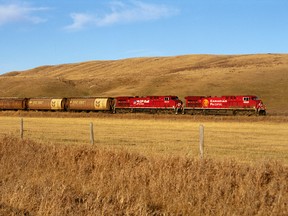
The remarks might come as a surprise to some in the industry, mostly because grain shippers in Canada aren’t known for being satisfied with the transportation system. One of the defining aspects of the grain business, especially lately, has been its relentless frustration with poor service from the railways. (In fact, Heimbecker made that quite clear: “I’ve got lots of problems with the railways, but they’ve spent massive amounts of money in the last 20 years upgrading the rail, their car fleets.” Then, for good measure: “And I’m no fan of the railway here.”)
Advertisement 8
Article content
Fixing the system, for Heimbecker, isn’t really about money. Sure, the infrastructure could use some investment. “And I have lots of ideas on how we could do that,” he said. “But I think the problem is complete mismanagement by the government. Our supply chain’s biggest problems emanate from ourselves.”
That’s a common gripe. Shippers have been particularly critical of the government for regulatory red tape that causes backlogs, including a rule on the B.C. coast, rarely observed at other international ports, that essentially prevents most grain ships from loading in the rain, which can waste a lot of time in a place as damp as Vancouver.
One of Heimbecker’s main critiques of the government, one that’s mostly absent from the task force’s recommendation, is that it’s been too soft on the two companies that control the rail system: CN and its long-time rival, Canadian Pacific Railway Ltd.
Advertisement 9
Article content
Grain elevators in rural areas are typically served by CN or CP, not both. Alghabra’s task force noted that those relationships between grain shippers and the big railroads aren’t “balanced by normal market forces.” In other words, grain companies are stuck with whichever railway runs through town, with little choice but to accept whatever train service they’re offered.

“You’ve got two railways that act as a virtual monopoly,” Heimbecker said. “When you’re negotiating with monopolies, it’s just, they become very difficult.”
It’s a critique that has been levelled at the federal government again and again, for allowing a handful of companies in a handful of industries to hoover up rivals and snuff out competition — grocery retail, air travel, telecommunications, banking.
Advertisement 10
Article content
“Canada is a country of oligopolies,” said David Gillen, a professor of operations and logistics at the University of British Columbia’s Sauder School of Business, who serves as director of the school’s Centre for Transportation Studies.
The question is: what’s to be done about it?
How to crack a monopoly
Alghabra’s task force suggested you could increase competition by expanding a concept in federal transport law known as interswitching. If a grain shipper’s facility is on a CN line, but that line intersects with a nearby CP line, federal rules dictate that CN has to bring the shipper’s freight to the CP line. As the rule is written right now, the interchange has to be within 30 kilometres of the shipper’s facility. The task force wants Ottawa to increase that limit, by next spring, but the report doesn’t give a new number on how wide the new interswitch zone should be.
Advertisement 11
Article content
Alghabra is “reviewing” the recommendation, spokesperson Nadine Ramadan said in an email.
In theory, the change would inject more competition into the system, Heimbecker said, but it would have to include language that would stop the railways from dragging their feet.
“I’m worried about the detail,” he said. “How does that work? And when am I going to get those cars? The railways won’t co-operate. If I order (rail cars) in next week, do I get them? Or do I get them in two or three weeks?”
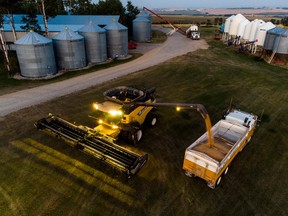
Delays on the rail network have been a sore subject for the grain industry this fall.
Farmers across the Prairies finished harvesting their grain in October, yielding an expected 75.2 million tonnes, according to forecasts by Statistics Canada. That’s enough to make this harvest a “top five all-time Canadian crop,” Ghislain Houle, CN’s chief financial officer, said on a call with analysts on Oct. 25.
Advertisement 12
Article content
This harvest has become one of the most anticipated in recent memory, coming off the fields at a time when Canadian grain storages are empty following last year’s drought, food retail inflation is at a 41-year high and the war in Ukraine has cast a shadow of uncertainty around the global food supply.
So Canada’s grain exporters want to get the crops onto trains and into global markets as soon as possible, before Australia’s grain harvest enters the market in December and drives down prices, according to Wade Sobkowich, who leads the industry’s main lobby group, the Western Grain Elevator Association.
For months, CP and CN braced for the surge, bulking up their fleets with new grain hopper cars and trying to hire new staff.
Advertisement 13
Article content
“Every kernel that’s harvested this year is going to want to move,” CN’s CEO Tracy Robinson said on May 17. “We need to be ready for that.”
Excuses
But by the fall, CN started making excuses. In its annual grain plan, the railway said it wouldn’t be able to keep pace with demand the last three months of 2022, in part because it wasn’t able to “hire and train all the conductors that we wanted” to have in place by harvest.
“One of the things that’s lost in this is, during the pandemic, both railways really downsized. They got rid of a number of people,” UBC’s Gillen said. “And now that demand is just growing like crazy, they don’t have the crews.”
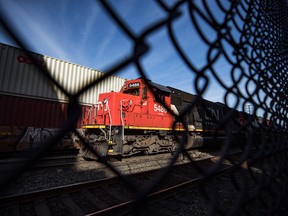
The railways appeared to start falling behind in September. A collection of grain industry lobby groups known as the Ag Transport Coalition tracks how many grain cars are ordered and how many the railways actually provide on a weekly basis. During the week of Sept. 18, CN and CP only provided about 70 per cent of all grain cars ordered by elevators in the week of Sept. 18, marking a “significant decline” from 83 per cent the previous week and well below “the 90 per cent threshold,” according to the coalition.
Advertisement 14
Article content
“This is the heavy shipping period and they’re already behind. And you know, once you get behind, it’s very hard to catch up,” Heimbecker said on Oct. 7. “It’s more or less the same story every year.”
The comeback
Through October, however, new reports and comments started to emerge, showing the railways have started to turn it around.
“We’re facing a bumper crop. We’ve got a lot of expectations. We’re going to meet expectations,” CP chief executive Keith Creel said during an earnings update on Oct. 26, adding that the railway had hired 1,500 conductors since the start of the year. “We’ve never been in better shape. Now, listen, I don’t want to get arrogant here at all. Mother Nature can humble us tomorrow. That’s a tough railroad to operate in. But I’m very, very pleased.”
Advertisement 15
Article content
Fill rates improved consistently through September, hitting 86-per-cent fulfilment by the first week of October.
In that week, CP sent “the most hopper cars to western Canadian elevators in its history,” spokesperson Salem Woodrow said in an email earlier this month.
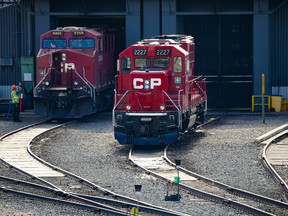
And this week, CN sent out a news release boasting that it had shattered an internal record on grain shipments. During the week of Oct. 17, CN moved over 806,000 tonnes of grain, beating a previous record by over 50,000 metric tonnes. “This record also comes on the heels of CN’s second best September ever for grain movement from Western Canada, with over 2.64 million metric tonnes moved,” the company said.
Sobkowich, the grain lobbyist, said he welcomed the new record, then added: “Even an amateur golfer is known to hit a hole in one once in a while … What turns that golfer into a pro is hitting good shots consistently.”
Advertisement 16
Article content
CN has been vocal about the grain industry’s unrealistic demands on its network during the harvest this year. David Przednowek, who heads CN’s grain unit, said last month that CN will be able to move this year’s grain harvest, but shipments need to be spread out over the crop year, which runs from Aug. 1, 2022 to July 31, 2023.
The railway is only one part of an interconnected supply chain, so it’s impacted by things outside its control, like weather and delays at port terminals, he said. If the industry wants to move the bulk of the harvest in the span of a few weeks, all through the same corridor through the Rockies, “it’s not going to fit,” Przednowek said in an interview last month. “There’s a limit to how much the supply chain can handle.”
Advertisement 17
Article content
That isn’t much comfort to John Heimbecker in Winnipeg.
“The harvest slot — October, November, December, January — this is when customers of Canada want the grain. That’s when we supply it,” he said. And if he doesn’t, he loses revenue and gets slapped with penalties for late deliveries.
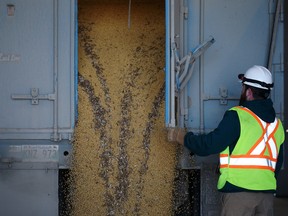
“Those costs are massive. They’re enormous,” he said. “If I don’t deliver my grain to (Japanese trading giant) Mitsui, I’ve got to pay,” Heimbecker continued. “If the railways are held accountable, they’ll perform.”
Most deals between grain elevators and the railways also involve penalties. The railroad agrees to send an elevator a certain amount of cars, and the elevator agrees to use them. If one side doesn’t hold up its end, there’s a cost for that.
Advertisement 18
Article content
To add an extra layer of fairness, the federal government allows shippers to take the railways to binding arbitration if they don’t like the deal.
In statements for this story, both CN and CP pointed to this system as proof that they are held accountable for the level of service they provide to shippers. Heimbecker said the federal protection has helped, but it’s not enough.
It’s not that the railways can’t move the grain. It’s that they won’t move it
John Heimbecker
“It’s not that the railways can’t move the grain. It’s that they won’t move it,” Heimbecker said. “And they won’t do it because they pick and choose. They pick the highest margin products to move at the time.”
Grain isn’t the most lucrative commodity the railways move. According to CN’s latest quarterly update, the “grain and fertilizers” category earned $5.20 for every ton shipped a single mile. Petroleum earned $7.26 per ton per mile in the third quarter. Metals and minerals fetched $7.24, forestry products made $8.32, and coal earned $4.47.
Advertisement 19
Article content
Sobkowich made a similar allegation earlier in the harvest, accusing the rail companies of reallocating resources to take advantage of a recent surge in coal shipments. “CP shows no preference to coal or, for that matter, any specific commodity,” CP spokesperson Salem Woodrow said last month. CN went even further, explaining that siphoning resources from grain shipments to another commodity wouldn’t make sense, because they use different types of rail cars, different routes and different crews.
Przednowek, CN’s assistant vice-president for grain, said crews are based in one place, and only work on a short stretch of a rail line, so it isn’t as simple as moving a crew from one commodity, in one region, to another commodity somewhere else.
Advertisement 20
Article content
“It is absolutely not accurate to say, ‘Well we’re just moving a bunch of people from here over here to move a bunch of coal,’” he said. “That’s not the case at all. That is not how things work.”
‘Incentives are to shift’
Gillen, the director of UBC’s Centre for Transportation Studies, said this is a case where both sides are right and wrong at the same time. It’s true that switching over cars and assets to ship one commodity to another is a cumbersome process, but not impossible.
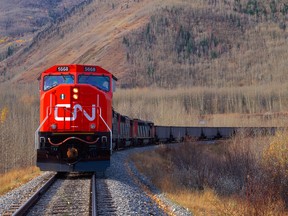
“It’s absolutely true that if you have a valuable commodity and you’re making more money on it, then why wouldn’t you want to do something like that?” he said. “If the grain companies want to pay more money in order to, in a sense, bid for that capacity, fair enough.”
Advertisement 21
Article content
The federal government, however, puts a cap on the amount of money that CN and CP can make from transporting western grain to provide some price protection for shippers — a program known as the maximum revenue entitlement.
“When you cap the revenue that can be earned from a service the incentives are to shift use of your capacity elsewhere,” Gillen added in an email.
Sobkowich and the grain elevators argue that they’re also at a disadvantage when negotiating with railways, since they can’t afford to go through the long and cumbersome federal arbitration process. If a grain elevator opted to contest a contract because they wanted the railway to send more railcars, for example, they would have to wait six months to a year for arbitration, he said. During that time, they’d have no contract and instead would have to vie for leftover after the railway fulfilled its contractual obligations to competing grain elevators, according to Sobkowich.
Advertisement 22
Article content
“Well, you’ve lost the harvest,” he said.
On top of that, arbitration can cost as much as $1 million in legal fees, according to Gillen.
But all the talk of lengthening interswitches, or making federal protections easier to access, ignores one of the more radical options when it comes to making the railways more competitive. That, Gillen said, would involve expanding access for third-party railroads to rent CN and CP tracks — something known as “running rights,” which are common in Australia and Europe.
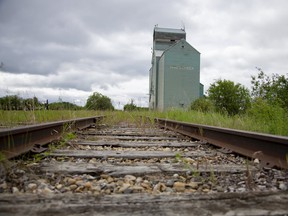
Expanding running rights for independent railways wouldn’t lead to the emergence of a third cross-country rail line, Gillen said. Instead, it might lead to a few grain shippers getting together to run a short line, from their remote region down to a main corridor, where they can access CN or CP trains easier than they could on a remote branch line, like the one up to Grande Prairie.
Advertisement 23
Article content
“The railways will fight it tooth and nail,” he said.
Indeed, CP responded to questions about running rights and interswitches by warning that more regulation from Ottawa could “increase the burden on the rail system, undermining the system’s efficiency.”
Back to the bridge
The bridge that burned down near Grande Prairie was a wood trestle bridge — a style that uses short spans held up by a series of towers in quick succession, each one stiffened by a weave of timber triangles. It was the sort of bridge that was in vogue when railroads expanded West in their golden age, more than a century ago, because they were easy to erect in rugged terrain and cheap to make, with timber in abundance.
-

Fragility of Canada’s supply chains on display as burning Alberta bridge stalls grain shipments
-

‘Very, very concerning’: Grain shippers fear railroads won’t be able to contend with bumper harvest
-

‘We’ve never been in better shape’: CP Rail boosts profit and outlook ahead of ‘top five all-time’ grain crops
-

CN boosts profit forecast after record revenues in third quarter
Advertisement 24
Article content
CN staff worked in shifts, coming in and out to the site from Grande Prairie, to fix it. Rather than rebuild it, the railway filled in the area where the 450-foot bridge once stood over the valley. The work continued 24 hours a day for just over a week. CN sent trains and trucks to the area, carrying enough earth to fill 20 Olympic swimming pools, according to a LinkedIn post written by the railway’s chief operating officer, Rob Reilly.
“This is an example of CN teamwork at its best,” Reilly wrote.
Eight days after the fire, on Oct. 13, the line to Grande Prairie was up and running again.
The bridge had been there since the late 1960s. In Reilly’s photo on LinkedIn, it is gone, just shiny tracks on a mound of gravel and fresh soil. So whatever it was, whatever’s left of it, whatever it represented about our system, good or bad, is now beneath 60,000 cubic yards of dirt.
• Email: jedmiston@postmedia.com | Twitter: jakeedmiston


